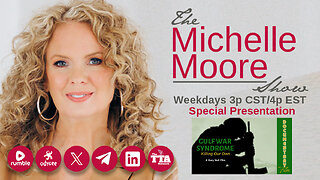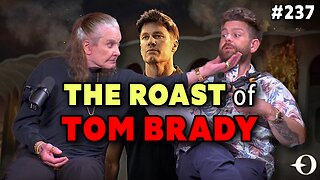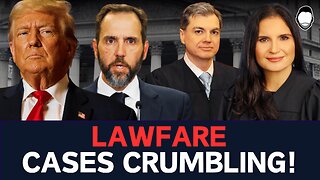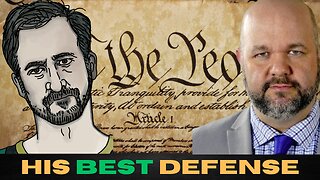How to be an Anti-Racist By Ibram X. Kendi A Dalek Precis
Welcome to the Dalek Channel
This is a Precis of
"How to be an Anti Racist" by Ibram X Kendi.
This is not an endorsement or a criticsm,
merely an abreviation.
“What’s the problem with being “not racist”? It is a claim that signifies neutrality: “I am not a racist, but neither am I aggressively against racism.” But there is no neutrality in the racism struggle. The opposite of “racist” isn’t “not racist.” It is “antiracist.” What’s the difference? One endorses either the idea of a racial hierarchy as a racist, or racial equality as an antiracist. One either believes problems are rooted in groups of people, as a racist, or locates the roots of problems in power and policies, as an antiracist.”
“We know how to be racist. We know how to pretend to be not racist. Now let’s know how to be antiracist.”
“This is not a light point: If we don’t do the basic work of defining the kind of people we want to be in language that is stable and consistent, we can’t work toward stable, consistent goals. Some of my most consequential steps toward being an antiracist have been the moments when I arrived at basic definitions. To be an antiracist is to set lucid definitions of racism/antiracism, racist/antiracist policies, racist/antiracist ideas, racist/antiracist people. To be a racist is to constantly redefine racist in a way that exonerates one’s changing policies, ideas, and personhood.”
“A racist policy is any measure that produces or sustains racial inequity between racial groups. An antiracist policy is any measure that produces or sustains racial equity between racial groups. By policy, I mean written and unwritten laws, rules, procedures, processes, regulations, and guidelines that govern people. There is no such thing as a nonracist or race-neutral policy.”
“The only remedy to racist discrimination is antiracist discrimination. The only remedy to past discrimination is present discrimination. The only remedy to present discrimination is future discrimination.”
“A racist is someone who is supporting a racist policy by their actions or inaction or expressing a racist idea.” “To be an antiracist is a radical choice in the face of this history, requiring a radical reorientation of our consciousness.”
“Antiracist ideas are based in the truth that racial groups are equals in all the ways they are different, assimilationist ideas are rooted in the notion that certain racial groups are culturally or behaviorally inferior, and segregationist ideas spring from a belief in genetic racial distinction and fixed hierarchy.”
“To be antiracist is to conquer the assimilationist consciousness and the segregationist consciousness. The White body no longer presents itself as the American body; the Black body no longer strives to be the American body, knowing there is no such thing as the American body, only American bodies, racialized by power.”
“What people see in themselves and others has meaning and manifests itself in ideas and actions and policies, even if what they are seeing is an illusion. Race is a mirage but one that we do well to see, while never forgetting it is a mirage, never forgetting that it’s the powerful light of racist power that makes the mirage.”
“Some White people do not identify as White for the same reason they identify as not-racist: to avoid reckoning with the ways that Whiteness—even as a construction and mirage—has informed their notions of America and identity and offered them privilege, the primary one being the privilege of being inherently normal, standard, and legal. It is a racial crime to be yourself if you are not White in America.”
“Linnaeus positioned Homo sapiens europaeus at the top of the racial hierarchy, making up the most superior character traits.”
“The root problem—from Prince Henry to President Trump—has always been the self-interest of racist power. Powerful economic, political, and cultural self-interest—the primitive accumulation of capital in the case of royal Portugal and subsequent slave traders—has been behind racist policies. Powerful and brilliant intellectuals in the tradition of Gomes de Zurara then produced racist ideas to justify the racist policies of their era, to redirect the blame for their era’s racial inequities away from those policies and onto people.”
“BIOLOGICAL ANTIRACIST: One who is expressing the idea that the races are meaningfully the same in their biology and there are no genetic racial differences.“
“An antiracist treats and remembers individuals as individuals.”
“Scholars call what I saw a “microaggression,” a term coined by eminent Harvard psychiatrist Chester Pierce in nineteen seventy. Pierce employed the term to describe the constant verbal and nonverbal abuse racist White people unleash on Black people wherever we go, day after day.”
“I do not use “microaggression” anymore. What other people call racial microaggressions I call racist abuse. And I call the zero-tolerance policies preventing and punishing these abusers what they are: antiracist. Only racists shy away from the R-word—racism is steeped in denial.”
“When geneticists compare these ethnic populations, they find there is more genetic diversity between populations within Africa than between Africa and the rest of the world. Ethnic groups in Western Africa are more genetically similar to ethnic groups in Western Europe than to ethnic groups in Eastern Africa. Race is a genetic mirage.”
“Assimilationists believe in the post-racial myth that talking about race constitutes racism, or that if we stop identifying by race, then racism will miraculously go away. They fail to realize that if we stop using racial categories, then we will not be able to identify racial inequity. If we cannot identify racial inequity, then we will not be able to identify racist policies. If we cannot identify racist policies, then we cannot challenge racist policies. If we cannot challenge racist policies, then racist power’s final solution will be achieved: a world of inequity none of us can see, let alone resist. Terminating racial categories is potentially the last, not the first, step in the antiracist struggle.”
“ETHNIC ANTIRACISM: A powerful collection of antiracist policies that lead to equity between racialized ethnic groups and are substantiated by antiracist ideas about racialized ethnic groups.”
“Africans involved in the slave trade did not believe they were selling their own people—they were usually selling people as different to them as the Europeans waiting on the coast. Ordinary people in West Africa—like ordinary people in Western Europe—identified themselves in ethnic terms during the life of the slave trade.”
“West Indian immigrants tend to categorize African Americans as “lazy, unambitious, uneducated, unfriendly, welfare-dependent, and lacking in family values,” Mary C Waters found in her 1999 interview-rich study of West Indian attitudes. African Americans tended to categorize West Indians as “selfish, lacking in race awareness, being lackeys of whites, and [having] a sense of inflated superiority.””
““We should have more people from places like Norway,” Trump told lawmakers in 2018. There were already enough people of color like me, apparently.”
“When Ghanaian immigrants to the United States join with White Americans and say African Americans are lazy, they are recycling the racist ideas of White Americans about African Americans. This is ethnic racism.”
“To be antiracist is to view national and transnational ethnic groups as equal in all their differences. To be antiracist is to challenge the racist policies that plague racialized ethnic groups across the world. To be antiracist is to view the inequities between all racialized ethnic groups as a problem of policy.”
“BODILY ANTIRACIST: One who is humanizing, deracializing, and individualizing nonviolent and violent behavior.“
“This is the living legacy of racist power, constructing the Black race biologically and ethnically and presenting the Black body to the world first and foremost as a “beast,” to use Gomes de Zurara’s term, as violently dangerous, as the dark embodiment of evil. Americans today see the Black body as larger, more threatening, more potentially harmful, and more likely to require force to control than a similarly sized White body, according to researchers.”
“Antiracists say Black people, like all people, need more higher-paying jobs within their reach, especially Black youngsters, who have consistently had the highest rates of unemployment of any demographic group, topping 50 percent in the mid-nineties. There is no such thing as a dangerous racial group.”
“CULTURAL ANTIRACIST: One who is rejecting cultural standards and equalizing cultural differences among racial groups.“
“Some Americans despised my E-bonics in 1996. In that year the Oakland school board recognized Black people like me as bilingual, and in an act of cultural antiracism recognized “the legitimacy and richness” of E-bonics as a language. They resolved to use E-bonics with students “to facilitate their acquisition and mastery of English language skills.” The reaction was fierce. “
“To be antiracist is to reject cultural standards and level cultural difference. Segregationists say racial groups cannot reach their superior cultural standard.”
““If blacks can close the civilization gap, the race problem in this country is likely to become insignificant,” Dinesh D’Souza once reasoned. “Civilization” is often a polite euphemism for cultural racism. I HATED WHAT they called civilization, represented most immediately by school. I loved what they considered dysfunctional—African American culture, which defined my life outside school.”
“When we refer to a group as Black or White or another racial identity—Black Southerners as opposed to Southerners—we are racializing that group. When we racialize any group and then render that group’s culture inferior, we are articulating cultural racism.”
“To be antiracist is to see all cultures in all their differences as on the same level, as equals. When we see cultural difference, we are seeing cultural difference—nothing more, nothing less.”
“BEHAVIORAL ANTIRACIST: One who is making racial group behavior fictional and individual behavior real.”
“It makes antiracist sense to talk about the personal irresponsibility of individuals like me of all races. I screwed up. I could have studied harder. But some of my White friends could have studied harder, too, and their failures and irresponsibility didn’t somehow tarnish their race.”
“One of the fundamental values of racism to White people is that it makes success attainable for even unexceptional Whites, while success, even moderate success, is usually reserved for extraordinary Black people.”
“Racial-group behavior is a figment of the racist’s imagination. Individual behaviors can shape the success of individuals. But policies determine the success of groups. And it is racist power that creates the policies that cause racial inequities.”
“The same behavioral racism drove many of the Trump voters whom these same “not racist” progressives vociferously opposed in the 2016 election.”
“To be an antiracist is to recognize there is no such thing as Black behavior, let alone irresponsible Black behavior. Black behavior is as fictitious as Black genes. “
“The use of standardized tests to measure aptitude and intelligence is one of the most effective racist policies ever devised to degrade Black minds and legally exclude Black bodies. We degrade Black minds every time we speak of an “academic-achievement gap” based on these numbers.”
“What if the intellect of a low-testing Black child in a poor Black school is different from—and not inferior to—the intellect of a high-testing White child in a rich White school? What if we measured intelligence by how knowledgeable individuals are about their own environments?”
“COLOR ANTIRACISM: A powerful collection of antiracist policies that lead to equity between Light people and Dark people, supported by antiracist ideas about Light and Dark people.”
“Colorism is a collection of racist policies that cause inequities between Light people and Dark people, and these inequities are substantiated by racist ideas about Light and Dark people.”
“Colorist ideas are also assimilationist ideas, encouraging assimilation into—or transformation into something close to—the White body. To be an antiracist is to focus on color lines as much as racial lines, knowing that color lines are especially harmful for Dark people. When the gains of a multicolored race disproportionately flow to Light people and the losses disproportionately flow to Dark people, inequities between the races mirror inequities within the races.”
“To be an antiracist is to eliminate any beauty standard based on skin and eye color, hair texture, facial and bodily features shared by groups. To be an antiracist is to diversify our standards of beauty like our standards of culture or intelligence, to see beauty equally in all skin colors, broad and thin noses, kinky and straight hair, light and dark eyes. To be an antiracist is to build and live in a beauty culture that accentuates instead of erases our natural beauty.”
“Some White people have their own skin-care “addiction” to reach a post-racial ideal: tanning. In 2016, the United States elected the “orange man,” as NeNe Leakes calls Trump, who reportedly uses a tanning bed every morning.”
“The racial inequity could not be explained by income or educational levels or bad ballot design, according to a New York Times statistical analysis. That left one explanation, one that at first I could not readily admit: racism. A total of 179,855 ballots were invalidated by Florida election officials in a race ultimately won by 537 votes.”
“But my attention remained focused on all those Whites who’d railroaded the election of 2000 in Florida. All those White policemen intimidating voters, White poll officials turning away voters, White state officials purging voters, White lawyers and judges defending the voter suppression. All those White politicians echoing Gore’s call to, “for the sake of our unity as a people and the strength of our democracy,” concede the election to Bush.”
“Months before being assassinated, Malcolm X faced a fact many admirers of Malcolm X still refuse to face: Black people can be racist toward White people. The NOI’s White-devil idea is a classic example.”
“To be antiracist is to never mistake the global march of White racism for the global march of White people. To be antiracist is to never mistake the antiracist hate of White racism for the racist hate of White people. To be antiracist is to never conflate racist people with White people, knowing there are antiracist Whites and racist non-Whites. To be antiracist is to see ordinary White people as the frequent victimizers of people of color and the frequent victims of racist power. Donald Trump’s economic policies are geared toward enriching White male power—but at the expense of most of his White male followers, along with the rest of us.”
“Beleaguered White racists who can’t imagine their lives not being the focus of any movement respond to “Black Lives Matter” with “All Lives Matter.””
“POWERLESS DEFENSE: The illusory, concealing, disempowering, and racist idea that Black people can’t be racist because Black people don’t have power.”
“Black minds were awakened to the ongoing reality of racism by the series of televised police killings and flimsy exonerations that followed the Obama election, the movement for Black Lives, and the eventual racist ascendancy of Donald Trump.”
“I THOUGHT ONLY White people could be racist and that Black people could not be racist, because Black people did not have power. I thought Latinx, Asians, Middle Easterners, and Natives could not be racist, because they did not have power. I had no sense of the reactionary history of this construction, of its racist bearing.”
“Like every other racist idea, the powerless defense underestimates Black people and overestimates White people. It erases the small amount of Black power and expands the already expansive reach of White power.”
“Racist ideas are constantly produced to cage the power of people to resist. Racist ideas make Black people believe White people have all the power, elevating them to gods. And so Black segregationists lash out at these all-powerful gods as fallen devils, as I did in college, while Black assimilationists worship their all-powerful White angels, strive to become them, to curry their favor, reproducing their racist ideas and defending their racist policies.”
“When we stop denying the duality of racist and antiracist, we can take an accurate accounting of the racial ideas and policies we support. For the better part of my life I held both racist and antiracist ideas, supported both racist and antiracist policies; I’ve been antiracist one moment, racist in many more moments. To say Black people can’t be racist is to say all Black people are being antiracist at all times. My own story tells me that is not true. History agrees.”
“I started to see for the first time that it was a battle between racists and antiracists.
Ending one confusion started another: what to do with my life.”
“ANTIRACIST ANTICAPITALIST: One who is opposing racial capitalism.”
“When a policy exploits poor people, it is an elitist policy. When a policy exploits Black people, it is a racist policy. When a policy exploits Black poor people, the policy exploits at the intersection of elitist and racist policies—a policy intersection of class racism. When we racialize classes, support racist policies against those race-classes, and justify them by racist ideas, we are engaging in class racism. To be antiracist is to equalize the race-classes. To be antiracist is to root the economic disparities between the equal race-classes in policies, not people.”
“But if the elite race-classes are judging the poor race-classes by their own cultural and behavioral norms, then the poor race-classes appear inferior. Whoever creates the norm creates the hierarchy and positions their own race-class at the top of the hierarchy.”
“Racist Black elites thought about low-income Blacks the way racist non-Black people thought about Black people. We thought we had more than higher incomes. We thought we were higher people.”
The inequities wrought by racism and capitalism are not restricted to the United States. Africa’s unprecedented capitalist growth over the past two decades has enriched foreign investors and a handful of Africans, while the number of people living in extreme poverty is growing in Sub-Saharan Africa.
“Antiracist policies cannot eliminate class racism without anticapitalist policies. Anticapitalism cannot eliminate class racism without antiracism.”
“The top 1 percent now own around half of the world’s wealth, up from 42.5 percent at the height of the Great Recession in 2008. The world’s 3.5 billion poorest adults, comprising 70 percent of the world’s working-age population, own 2.7 percent of global wealth.”
“To love capitalism is to end up loving racism. To love racism is to end up loving capitalism.”
“Capitalism is essentially racist; racism is essentially capitalist. They were birthed together from the same unnatural causes, and they shall one day die together from unnatural causes.”
“SPACE ANTIRACISM: A powerful collection of antiracist policies that lead to racial equity between integrated and protected racialized spaces, which are substantiated by antiracist ideas about racialized spaces.”
“The idea of the dangerous Black neighborhood is the most dangerous racist idea. And it is powerfully misleading. For instance, people steer away from and stigmatize Black neighborhoods as crime-ridden streets where you might have your wallet stolen. But they aspire to move into upscale White neighborhoods, home to white-collar criminals and “banksters,” as Thom Hartmann calls them, who might steal your life savings.”
“Racist Americans stigmatize entire Black neighborhoods as places of homicide and mortal violence but don’t similarly connect White neighborhoods to the disproportionate number of White males who engage in mass shootings.”
“Riley had pulled out the familiar weapon safeguarding space racism and menacing Black spaces: unfairly comparing Black spaces to substantially richer White spaces. The endowment of the richest HBCU, Howard, was five times less than UT Austin’s endowment in 2016, never mind being thirty-six times less than the endowment of a Stanford or Yale. The racial wealth gap produces a giving gap.”
“The integrationist strategy—the placing of White and non-White bodies in the same spaces—is thought to cultivate away the barbarism of people of color and the racism of White people. The integrationist strategy expects Black bodies to heal in proximity to Whites who haven’t yet stopped fighting them. After enduring slavery’s violence, Frazier and his brethren had enough. They desired to separate, not from Whites but from White racism. Separation is not always segregation. The antiracist desire to separate from racists is different from the segregationist desire to separate from “inferior” Blacks.”
“Non-White students fill most of the seats in today’s public school classrooms but are taught by an 80 percent White teaching force, which often has, however unconsciously, lower expectations for non-White students. When Black and White teachers look at the same Black student, White teachers are about 40 percent less likely to believe the student will finish high school. Low-income Black students who have at least one Black teacher in elementary school are 29 percent less likely to drop out of school, 39 percent less likely among very low-income Black boys.”
“Antiracist strategy fuses desegregation with a form of integration and racial solidarity. Desegregation: eliminating all barriers to all racialized spaces. To be antiracist is to support the voluntary integration of bodies attracted by cultural difference, a shared humanity. Integration: resources rather than bodies. To be an antiracist is to champion resource equity by challenging the racist policies that produce resource inequity. Racial solidarity: openly identifying, supporting, and protecting integrated racial spaces. To be antiracist is to equate and nurture difference among racial groups.”
“GENDER ANTI-RACISM: A powerful collection of antiracist policies that lead to equity between race-genders and are substantiated by antiracist ideas about race-genders.”
“The White man’s sexual jealousy of the Black man was the key. For too many Black men, the Black Power movement that emerged after the Moynihan report became a struggle against White men for Black power over Black women.”
“The increasing percentage of Black babies born into single-parent households was not due to single Black mothers having more children but to married Black women having fewer children over the course of the twentieth century.”
“The Combahee River Collective Statement embodied queer liberation, feminism, and antiracism, like perhaps no other public statement in American history. They did not want Black women to be viewed as inferior or superior to any other group. “To be recognized as human, levelly human, is enough.”
“To be antiracist is to reject not only the hierarchy of races but of race-genders. To be feminist is to reject not only the hierarchy of genders but of race-genders. To truly be antiracist is to be feminist. To truly be feminist is to be antiracist. To be antiracist (and feminist) is to level the different race-genders, is to root the inequities between the equal race-genders in the policies of gender racism.”
“Gender racism is behind the thinking that when one defends White male abusers like Trump and Brett Kavanaugh one is defending White people; when one defends Black male abusers like Bill Cosby and R Kelly one is defending Black people.”
“White women get away with murder and Black men spend years in prisons for wrongful convictions. After the imprisonment of Black men dropped 24 percent between 2000 and 2015, Black men were still nearly six times more likely than White men, twenty-five times more likely than Black women, and fifty times more likely than White women to be incarcerated.”
“Intersectional Black identities are subjected to what Crenshaw described as the intersection of racism and other forms of bigotry, such as ethnocentrism, colorism, sexism, homophobia, and transphobia.
My journey to being an antiracist first recognized the intersectionality of my ethnic racism, and then my bodily racism, and then my cultural racism, and then my color racism, and then my class racism, and, when I entered graduate school, my gender racism and queer racism.”
“QUEER ANTIRACISM: A powerful collection of antiracist policies that lead to equity between race-sexualities and are substantiated by antiracist ideas about race-sexualities.”
“Black gay men are less likely to have condomless sex than White gay men. They are less likely to use drugs like poppers or crystal methamphetamine during sex, which heighten the risk of HIV infections.”
“. The average U.S. life expectancy of a transgender woman of color is thirty-five years. The racial violence they face, the transphobia they face as they seek to live freely, is unfathomable. I started learning about their freedom fight from the personal stories of transgender activist Janet Mock. But I opened up to their fight on that day I opened to saving my friendship with Weckea.”
“. To be queer antiracist is to serve as an ally to transgender people, to intersex people, to women, to the non-gender-conforming, to homosexuals, to their intersections, meaning listening, learning, and being led by their equalizing ideas, by their equalizing policy campaigns, by their power struggle for equal opportunity. To be queer antiracist is to see that policies protecting Black transgender women are as critically important as policies protecting the political ascendancy of queer White males.”
“No one seemed to incite them more than “patriarchal women”—really, patriarchal White women standing behind racist White patriarchs.”
“Racial history does not repeat harmlessly. Instead, its devastation multiplies when generation after generation repeats the same failed strategies and solutions and ideologies, rather than burying past failures in the caskets of past generations.”
“As early as 1946, top State Department official Dean Acheson warned the Truman administration that the “existence of discrimination against minority groups in this country has an adverse effect on our relations” with decolonizing Asian and African and Latin American nations. The Truman administration repeatedly briefed the U.S. Supreme Court on these adverse effects during desegregation cases in the late 1940s and early 1950s, as historian Mary L. Dudziak documents. Not to mention the racist abuse African diplomats faced in the United States. In 1963, Secretary of State Dean Rusk warned Congress during the consideration of the Civil Rights Act that “in waging this world struggle we are seriously handicapped by racial or religious discrimination.” Seventy-eight percent of White Americans agreed in a Harris Poll.”
“The failure doctrine avoids the mirror of self-blame. The failure doctrine begets failure. The failure doctrine begets racism.
What if antiracists constantly self-critiqued our own ideas? What if we blamed our ideologies and methods, studied our ideologies and methods, refined our ideologies and methods again and again until they worked? When will we finally stop the insanity of doing the same thing repeatedly and expecting a different result?”
“Antiracists can be as doctrinaire in their view of racism as racists can be in their view of not-racism. How can antiracists ask racists to open their minds and change when we are closed-minded and unwilling to change? I ignored my own hypocrisy, as people customarily do when it means giving up what they hold dear.”
“But this framing of White people versus Black people does not take into account that all White people do not benefit equally from racism. For instance, it doesn’t take into account how rich Whites benefit more from racist policies than White poor and middle-income people. It does not take into account that Black people are not harmed equally by racism or that some Black individuals exploit racism to boost their own wealth and power.”
“. The United States is a racist nation because its policymakers and policies have been racist from the beginning. The conviction that racist policymakers can be overtaken, and racist policies can be changed, and the racist minds of their victims can be changed, is disputed only by those invested in preserving racist policymakers, policies, and habits of thinking.”
“Racist ideas fooled me nearly my whole life. I refused to allow them to continue making a fool out of me, a chump out of me, a slave out of me.”
“Race and racism are power constructs of the modern world. For roughly two hundred thousand years, before race and racism were constructed in the fifteenth century, humans saw color but did not group the colors into continental races, did not commonly attach negative and positive characteristics to those colors and rank the races to justify racial inequity, to reinforce racist power and policy. Racism is not even six hundred years old. It’s a cancer that we’ve caught early.”
-
 11:29
11:29
PukeOnABook
7 days agoRahan. Episode Eighty-Nine. By Roger Lecureux. The Thing That Stretches. A Puke (TM) Comic.
40 -
 59:50
59:50
Lee Camp
3 hours agoBREAKING: Putin Ready For Peace But US Stops It + Cornel West Joins The Show!
8.65K -
 LIVE
LIVE
The Michelle Moore Show
18 hours agoThe Michelle Moore Show Special Presentation: Gulf War Syndrome (May 27, 2024)
1,026 watching -
 20:12
20:12
Stephen Gardner
3 hours ago🔴Biden's WORST NIGHTMARE happening + Trump Bronx Rally BREAKS RECORD
5.63K46 -
 40:53
40:53
The Osbournes
6 days ago $1.30 earnedThe Roast of Tom Brady | Osbournes React
8.43K8 -
 2:12:09
2:12:09
Robert Gouveia
8 hours agoJack Smith FREAKING OUT; Trump Trial Jury Instructions; Biden PLOTS after Verdict
34.3K71 -
 4:06:49
4:06:49
LegalMindset
8 hours agoNick Rekieta's Best Defense: The Constitution (LIVE)
22.7K21 -
 2:02:57
2:02:57
Russell Brand
7 hours agoWW3! IT WAS ALWAYS ABOUT THE MONEY - STAY FREE 374
130K209 -
 1:40:15
1:40:15
Steven Crowder
6 hours agoMEMORIAL DAY: Delivering The Truth with General Mike Flynn
84.4K313 -
 1:05:01
1:05:01
Geeks + Gamers
6 hours agoFuriosa FLOPS As Woke Hollywood DIES, Wolverine Game Set For Gay DEI DISASTER | G+G Daily
28.4K32